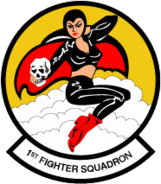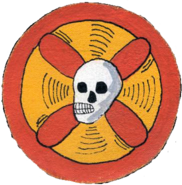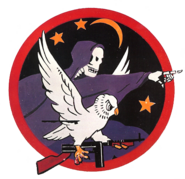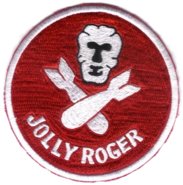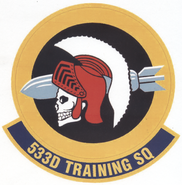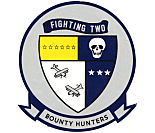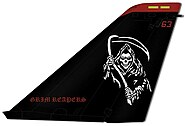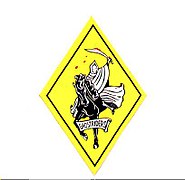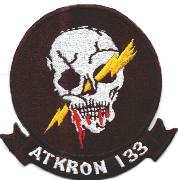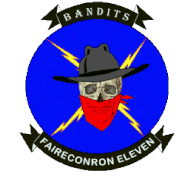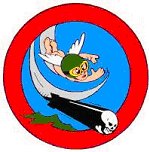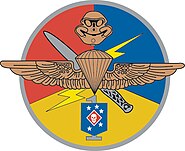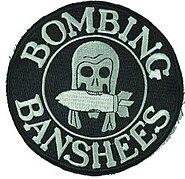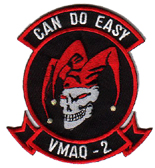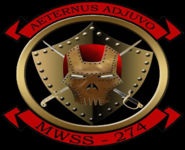Variations on the skull and crossbones have been used by several military forces. The largest is on the "Jolly Roger" flags used by submarines.
Usage[]
[]
The Jolly Roger is the name given to any of various flags flown to identify a ship's crew as pirates. Since the decline of piracy, various military units have used the Jolly Roger, usually in skull-and-crossbones design, as a unit identification insignia or a victory flag to ascribe to themselves the proverbial ferocity and toughness of pirates.

6 February 1942 Members of the crew of HMS Utmost with their "Jolly Roger" success flag, photographed alongside submarine depot ship HMS FORTH in Holy Loch, on their return from a year's service in the Mediterranean
Admiral Sir Arthur Wilson VC, the Controller of the Royal Navy, summed up the opinion of the many in the Admiralty at the time when in 1901 he said submarines were "underhand, unfair, and damned un-English. ... treat all submarines as pirates in wartime ... and hang all crews."[1][2] In response, Lieutenant Commander (later Admiral Sir) Max Horton first flew the Jolly Roger on return to port after sinking the German cruiser SMS Hela and the destroyer SMS S-116 in 1914 while in command of the E class submarine HMS E9.[3][4]
In World War II it became common practice for the submarines of the Royal Navy to fly the Jolly Roger on completion of a successful combat mission where some action had taken place, but as an indicator of bravado and stealth rather than of lawlessness. The Jolly Roger is now the emblem of the Royal Navy Submarine Service.

A US Navy F/A-18F Super Hornet aircraft assigned to the "Jolly Rogers" of Strike Fighter Squadron 103 (VFA-103), prepares to launch from the flight deck of the Nimitz-class Aircraft Carrier USS Dwight D. Eisenhower, 2006.
Three distinct U.S. Naval Aviation squadrons have used the name and insignia of the Jolly Roger: VF-61 (originally VF-17), VF-84, and VFA-103. While these are distinctly different squadrons that have no lineal linkage, they all share the same Jolly Roger name, the skull and crossbones insignia and traditions.[5] The first incarnation of the Jolly Rogers was established on January 1, 1943 at NAS Norfolk, as VF-17, flying the F4U Corsair. Inspired by the piratical theme of the aircraft's name, VF-17's commanding officer Tommy Blackburn selected the Jolly Roger as the squadron's insignia.[6] The current squadron to hold the name is the VFA-103, Strike Fighter Squadron 103 (the Jolly Rogers), the skull and crossbones on all-black tails makes them easily identifiable.
United States Marine Corps reconnaissance battalions also use a skull and cross bones on their emblems.[citation needed]
Land warfare[]
Hussars, lancers and dragoons became established types of military units, with their typical uniform patterns (and weapons and tactics) maintained in many armies (though in different colors), there once was a type of armthat had a black uniform and a rather large (≈10 cm) skull and crossbones on a black cay unit.[citation needed]
In Chile, during the independence battles, a paramilitary guerrilla group against the royal Spanish army composed mainly by bandits and civilians, called "Los húsares de la muerte ("The Death Hussars") wore a Skull with two crossed femurs on the neck of their jackets.[citation needed]
In the Estonian War of Independence the skull and crossbones were symbols of Kuperjanov's Partisan Battalion. The badge is still used in the Estonian Army by the Kuperjanov Battalion, for example 2007 in Iraq.[7]
Though not employing a black uniform, the skull and crossbones has been used by a succession of lancer regiments in the British Army. The Queen's Royal Lancers continue to use the skull and crossbones in their emblem, inherited from its use by the 17th Light Dragoons - a unit raised in 1759 following General Wolfe's death at Quebec, with an emblem of a death's head and the words 'Or Glory' in commemoration of him.[8] The cap badge was later used by the 17th/21st Lancers and its present-day successor, the Queen's Royal Lancers who are still nicknamed the 'Death or Glory Boys'.[citation needed]
During the Russian Civil War, the troops of Nestor Makhno bore a skull and crossbones on their flag with the words "Freedom or Death," while the troops of the White Kornilov Division wore patches emblazoned with a skull and crossbones above a pair of crossed swords.[citation needed]
When Hitler gained power, there were still uniforms that were black and with a rather large (≈10 cm) skull and crossbones on a black cap, but the pattern was adapted for the Nazi SS service, with a "peaked cap" and a tiny skull and crossbones for the cap (≈2.5 cm). And in World War II, Nazi SS troops made use of the "Totenkopf" (German word for "dead man's head") as an insignia for another part of the uniform as well (in particular, the 3rd SS Division, which was a part of the larger Waffen SS), and also by the similarly named World War II-era Luftwaffe's 54th Bomber Wing (Kampfgeschwader 54)File:KG54 Totenkopf.jpg.
In the former Yugoslavia, and especially Serbia, the skull and crossbones was a prominent symbol used by the Serbian royalist and nationalist paramilitaries known as the Chetniks during the Second World War and the Yugoslav Wars.[citation needed]
Aerial warfare[]

The White Bird in which Nungesser disappeared in 1927

The Nieuport 17 fighter of Charles Nungesser
Fighter aircraft of both the Allied Powers and the Central Powers occasionally made use of the a Skull and crossbones emblem in World War I, either by itself or as part of a more complex insignia, more often by individual pilots, and in rare instances, by entire aviation units.[citation needed] The most memorable of these usages could be considered to be on the series of French fighter aircraft flown by French 43-victory flying ace Charles Nungesser, as all of his aircraft, both during and following World War I featured his personal "black heart" insignia on the sides of the aircraft's fuselage, centered on a Skull and crossbones emblem, accompanied with a coffin directly above the skull, and flanked with single candlesticks to either side of the emblem, all within the black heart-shaped field. He earned the nickname "Hussard de la mort" ("Horseman of Death") when as a cavalry man in the first days of the war, he captured a Mors (a luxury car) carrying four German Staff officers with operation plans [1]
Image gallery[]
See also[]
| Wikimedia Commons has media related to Skull and crossbones (military symbol). |
- 101 Squadron (Israel), which uses an "angel of death" logo variant since 1948
- Jolly Roger
- Totenkopf — "death's head" insignia of many elite military units
- Danse Macabre
References[]
- ↑ "underhand, unfair, and damned un-English."(Stephen Wentworth Roskill (1968). Naval Policy Between the Wars, Walker, ISBN 0-87021-848-4 p. 231. cites A. J. Marder, Fear God and Dread Nought, vol. I (Oxford UP, 1961), p. 333 and also Williams Jameson, The Most Formidable Thing (Hart-Davis, 1965) pp. 75-76.)
- ↑ "underhand, ... and damned Un-English. ... treat all submarines as pirates in wartime ... and hang all crews." (J. R. Hill (1989). Arms Control at Sea, Routledge, ISBN 0-415-01280-5. p. 35 cites Marder, From the Dreadnoughts to Scapa Flow p. 332).
- ↑ Staff, The Jolly Roger on a webpage of the National Museum of the Royal Navy.
- ↑ HMS Triumph and HMS Superb.
- ↑ Blackburn, Tom. The Jolly Rogers: The Story of Tom Blackburn and Navy Fighting Squadron VF-17. Crown, 1988. ISBN 0-5175-7075-, p. 41.
- ↑ overview (in Estonian)[need quotation to verify]
- ↑ http://www.qrl.uk.com/h_home.html[dead link]
–The Skull and Cross Bones was originally the maritime battle flag of the Knights Templer. (Knight, Christopher and Robert Lomas, The Hiram Key et al., Arrow Books, London, 1997.)
The original article can be found at Skull and crossbones (military) and the edit history here.























